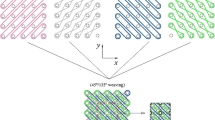Abstract
Modeling Kevlar yarn response as a function of twist requires creating a model at the filament level that incorporates capturing the mechanical interaction of numerous fibers. The inherent complexity of building a multiscale interwoven fibrous structure manually is prohibitive for such an endeavor; therefore, computer-aided simulations are preferred. In this study, a random walk methodology was employed to generate a fibrous structure along the axis of a yarn. Since the directionality of the fibers is randomly oriented along the axis, the fibers can wind around each other and tangle or terminate on demand. The resultant geometry can represent the tortuous path that yarn filaments experience. Yarn twist can be introduced through imposing a rotation matrix to the geometry or conducting an initial analysis that applies the preload. The analysis method employed in this paper captures the correct prestress of the twisted yarns at zero, three, and ten twists per inch. The analysis then loaded the yarn until filament fracture occurred. The predicted ultimate load was within 5% for all three twists per inch analyzed. The zero twists per inch linear response matched test results to within 5%.
Similar content being viewed by others
References
Administration, National Highway Traffic Safety. The Pneumatic Tire. DOT HS 810 561 (2006)
Gao, X.-L.: (The University of Texas at Dallas). A Final Report Given to U.S Army PEO Office: Tensile Test Results of the Dyneema SK76 1500-dtex yarn and Kevlar KM2 600-denier yarn at different twist levels. Period of Performance: 01/23/2011–08/31/2012
ASTMD7269: Standard Test Methods for Tensile Testing of Aramid Yarns. West Conshohocken, PA (2011)
Iorga L., Pan Y., Pelegri A.A.: Analysis of 3D random chopped fiber reinforced composites using FEM and random sequential adsorption. Comput. Mater. Sci. 43(3), 450–461 (2008)
Liu Y.J., Chen X.L.: Evaluations of the effective material properties of carbon nanotube-based composites using a nanoscale representative volume element. Mech. Mater. 35, 69–81 (2003)
Li S., Thouless M.D., Waas A.M., Schroeder J.A., Zavattieri P.D.: Use of a cohesive-zone model to analyze the fracture of a fiber-reinforced polymer-matrix composite. Compos. Sci. Technol. 65(3–4), 537–549 (2005)
Shan B., Pelegri A.A., Pan Y.: Interfacial crack kinking subjected to contact effects. J. Mech. Mater. Struct. 3(4), 591–605 (2008)
Recchia, S.S., Pelegri, A.A., Zheng, J., Chasiotis, I., Clawson, J.K., Sahin, K.A.: Hierarchical model for Kevlar fiber failure. In: Proceedings of the ASME 2013 International Mechanical Engineering Congress and Exposition, vol. 4 (2013)
Favier V., Dendievel R., Canova G.: Simulation and modeling of three-dimensional percolating structures: case of a latex matrix reinforced by a network of cellulose fibers. Acta Mater. 45(4), 1557–1565 (1997)
Knauss, W.G., Chasiotis, I.: Experimentation at the micron–submicron scale. In: Comprehensive Structural Integrity, Interfacial and Nanoscale Failure, vol. 8, pp. 41–87. Elsevier, Amsterdam (2003)
Dobb M.G., Johnson D.J., Majeed A., Saville B.P.: Microvoids in aramid type fibrous polymers. Polymer 20, 1284–1288 (1979)
Naraghi M., Ozkan I., de Boer M.P., Hazra S., Chasiotis I.S.: MEMS platform for on-chip nanomechanical experiments with strong and highly ductile nanofibers. J. Micromech. Microeng. 20, 125022-1–125022-9 (2010)
Zhou G., Sun X.: Multi-chain digital element analysis in textile mechanics. Compos. Sci. Technol. 64, 239–244 (2003)
Lim T.-C.: Three-level hierarchical approach in modeling sheet thermoforming. Int. J. Mech. Sci. 45, 1097–1117 (2003)
Boubaker B., Haussy B., Ganghoffer J.-F.: Consideration of the yarn–yarn. Mech. Res. Commun. 34, 371–378 (2007)
D’Amato E.: Finite element modeling of textile composites. Compos. Struct. 54, 467–475 (2001)
Verberne, C.W.: Mechanical Modelling of Textiles. A Literature Survey. Report number MT10.1. University of Technology, Eindhoven (2010)
Loikkanen, M., Praveen, G., Powell, D.: Simulation of ballistic impact on composite panels. In: 10th International LS-DYNA Users Conference (2008)
Grujicic M., Bell W.C., Glomski P.S., Pandurangan B., Yen C.F., Cheeseman B.A.: Filament level modeling of aramid based high performance structural materials. J. Mater. Eng. Perform. 20, 1401–1413 (2011)
Altendorf H., Jeulin De.: Random walk based stochastic modeling of 3D fiber systems. Phys. Rev. 83, 10 (2010)
Berhan L., Sastry A.M.: Modeling percolation in high-aspect-ratio fiber systems II—the effect of waviness on the. Phys. Rev. 75, 4–041121 (2007)
Sandia National Labs: Cubit Home Manual. Sandia National Labs, Albuquerque (2015)
Recchia S.S., Zheng J., Pelegri A.A.: Fiberwalk: a random walk approach to fiber representative volume element creation. Acta Mech. 225, 1301–1312 (2014)
Cheng M., Chen W., Weerasooriya T.: Mechanical properties of Kevlar KM2 single fiber. J. Eng. Mater. Technol. 127, 197–203 (2005)
Sierra Solid Mechanics Team: Presto 4.16 Users Guide. Albuquerque (2010)
Corporation, Simulia. Abaqus 6.12 Analysis Users Manual, vol. V. Providence, RI (2010)
Author information
Authors and Affiliations
Corresponding author
Rights and permissions
About this article
Cite this article
Recchia, S., Zheng, J.Q., Horner, S. et al. Multiscale modeling of randomly interwoven fibers for prediction of KM2 Kevlar yarn strength and damage. Acta Mech 226, 4149–4158 (2015). https://doi.org/10.1007/s00707-015-1486-0
Received:
Revised:
Published:
Issue Date:
DOI: https://doi.org/10.1007/s00707-015-1486-0



